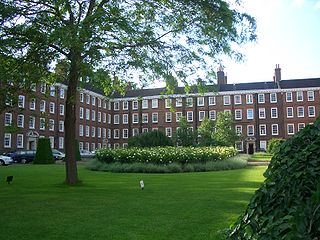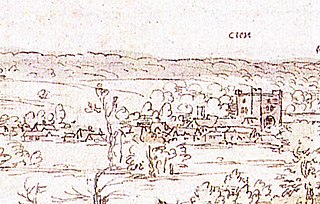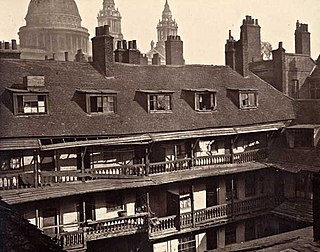Origins of the name
Some authors have speculated, without linguistic analysis, that the "Port" in Portpool refers to a gate [6] or a market. However, the earliest references to the name of the manor indicate that the first syllable is "Purt" ("Purtepol" c.1200 and 1203; "Purtepole" 1220 and 1309; "Pourtepol" 1316). This shows that it cannot be "port" in any sense of that word but instead a personal name, "Purta". It is therefore "Purta's Pool". [7] Certainly, it has not been convincingly shown that "port" refers to any particular gate or market, and indeed the idea of locating a gate or market near a pool is a little unusual.
Related Research Articles

Holborn is a district in the London boroughs of Camden and City of Westminster and a locality in the ward of Farringdon Without in the City of London. The area is sometimes described as part of the West End of London.

The Honourable Society of Gray's Inn, commonly known as Gray's Inn, is one of the four Inns of Court in London. To be called to the bar and practise as a barrister in England and Wales, a person must belong to one of these inns. Located at the intersection of High Holborn and Gray's Inn Road in Central London, the inn is both a professional body and a provider of office accommodation (chambers) for many barristers. It is ruled by a governing council called "pension", made up of the masters of the bench, and led by the Treasurer, who is elected to serve a one-year term. The inn is known for its gardens, or walks, which have existed since at least 1597.

East Sheen, also known as Sheen, is an affluent suburb of South London in the London Borough of Richmond upon Thames.

Barnard's Inn is a former Inn of Chancery in Holborn, London. It is now the home of Gresham College, an institution of higher learning established in 1597 that hosts public lectures.

Hatton Garden is a street and commercial area in the Holborn district of the London Borough of Camden, close to the boundary with the City of London. It takes its name from Sir Christopher Hatton, a favourite of Queen Elizabeth I, who established a mansion here and gained possession of the garden and orchard of Ely Place, the London seat of the Bishops of Ely. It remained in the Hatton family and was built up as a stylish residential development in the reign of King Charles II.

Baron Grey de Wilton is a title that has been created twice, once in the Peerage of England (1295) and once in the Peerage of Great Britain (1784). Both creations are now extinct.

Gray's Inn Road is an important road in the Bloomsbury district of Central London, in the London Borough of Camden. The road begins at the City of London boundary, where it bisects High Holborn, and ends at King's Cross and St. Pancras Station.

Reynold de Grey, 1st Baron Grey of Wilton was an English nobleman after whom one of the four Inns of Court is named. He was son of Sir John de Grey and grandson of Henry de Grey. The property upon which Gray's Inn sits was once Portpoole Manor held by Reginald de Grey.

The Bourne Estate is an Edwardian housing estate in the Holborn district of Central London. It is bounded by Clerkenwell Road to the north, Gray's Inn Road to the west, Leather Lane to the east and Baldwins Gardens to the south. It is also intersected by Portpool Lane, which forms part of the estate itself.

Sir Henry de Grey of Grays Thurrock, Essex (1155–1219) was a favourite courtier of King John of England.
Thavie's Inn was a former Inn of Chancery, associated with Lincoln's Inn, established at Holborn, near the site of the present side street and office block still known as Thavies Inn Buildings. Thavie's Inn is one of the earliest Inns of Chancery on record, both by date of establishment and dissolution. It remains a well-known City of London landmark, where Lloyd's Bank is situated, on the opposite side of Holborn Circus from Ely Place.
Hugh Denys of Osterley was a courtier of Kings Henry VII and of the young Henry VIII. As Groom of the Stool to Henry VII, he was one of the King's closest courtiers, his role developing into one of administering the Privy Chamber, a department in control of the royal finances which during Denys's tenure of office also gained control over national fiscal policy. Denys was thus a vital player in facilitating the first Tudor king's controversial fiscal policies.
St Andrew Holborn was an ancient English parish that until 1767 was partly in the City of London and mainly in the county of Middlesex. Its City, thus southern, part retained its former name or was sometimes officially referred to as St Andrew Holborn Below the Bars.
Sheen Friary later also known as Richmond Priory (1414-1539) was a friary in Surrey, England, restored as a national gathering of Carthusians by Maurice Chauncy at Sheen under Mary I of England during part of her reign from 1553 to 1558.

Sheen Priory in Sheen, now Richmond, London, was a Carthusian monastery founded in 1414 within the royal manor of Sheen, on the south bank of the Thames, upstream and approximately 9 miles southwest of the Palace of Westminster. It was built on a site approximately half a mile to the north of Sheen Palace, which itself also occupied a riverside site, that today lies between Richmond Green and the River Thames.

The Mirror of Justices, also known in Anglo-Norman as Le mireur a justices and in Latin as Speculum Justitiariorum, is a law textbook of the early 14th century, written in Anglo-Norman French by Andrew Horn. The original manuscript is in the Parker Library, Corpus Christi College, Cambridge.
The coat of arms of the London Borough of Camden is the official heraldic arms of the London Borough of Camden. The arms were granted on 10 September 1965. The borough was formed by the merger of three former boroughs, the Metropolitan Borough of Hampstead, the Metropolitan Borough of Holborn and the Metropolitan Borough of St. Pancras, and symbols from their old coats of arms were taken over to the new borough arms.

The Society for Photographing Relics of Old London was founded in 1875 in London, England, initially with the purpose of recording the Oxford Arms, a traditional galleried public house on Warwick Lane that was to be demolished as part of the redevelopment of the Old Bailey. Alfred & John Bool took the photographs, and when the project was announced in a letter to The Times, the news received such a positive response that the society's work was continued, with a total of twelve issues being produced over twelve years, containing a total of 120 photographs.
This is a list of the etymology of street names in the London district of Holborn. Holborn has no formally defined boundaries - those utilised here are: Theobald’s Road to the north, Gray's Inn Road and the City of London boundary to the east, Victoria Embankment/the Thames to the south, and Lancaster Place, the north-west curve of the Aldwych semi-circle, Kingsway/Southampton Row to the west.
References
- ↑ E. Williams, Early Holborn and the Legal Quarter of London, Vol 1, 1927.
- ↑ E. Williams, op. cit., para 599.
- ↑ Cal. Wills, i 48
- ↑ E. Williams, Staple Inn, 22, 38-44, and Douthwaite, Gray's Inn, 3-18
- ↑ John Timbs, Curiosities of London, 1867
- ↑ E. Williams, Early Holborn and the Legal Quarter of London, Vol 1, 1927
- ↑ J.E.B. Gover, The Place Names of Middlesex, London, 1922, pp 70-1 and 105.